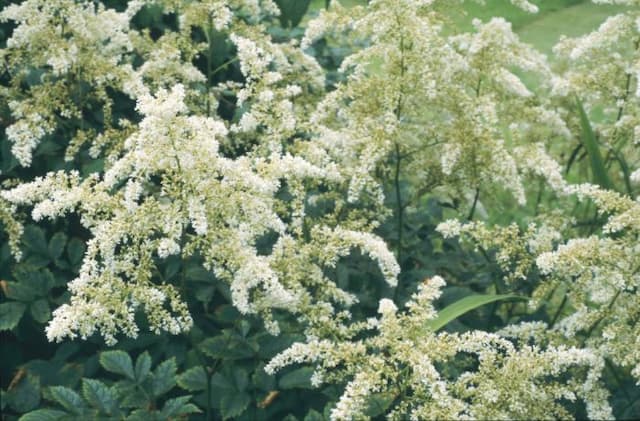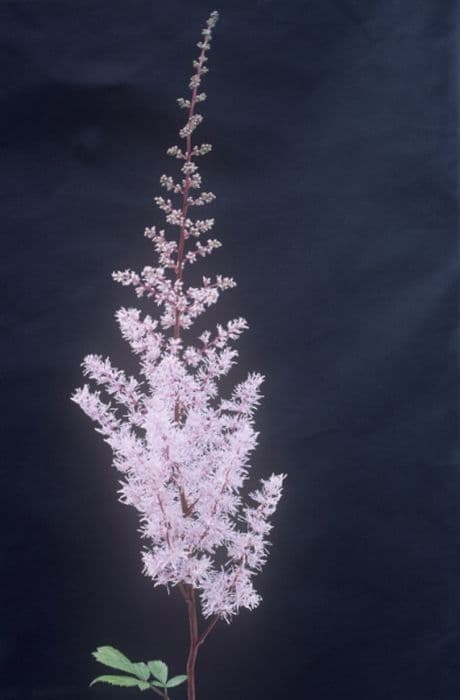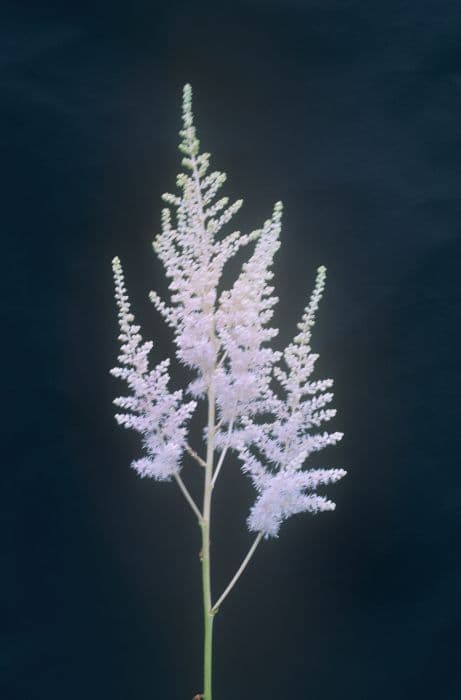Coral Bells Heuchera 'Shanghai' (PBR)

ABOUT
Heuchera 'Shanghai', commonly known as Coral Bells, is a decorative perennial plant with a striking appearance. It features a compact mound of dense foliage that adds texture and color to garden spaces. The leaves of the 'Shanghai' variety are particularly notable for their dark purple to nearly black tint, with a hint of a silver overlay that gives them a somewhat metallic sheen. The foliage is often rounded, with lobed edges and a ruffled look that adds a touch of elegance. In contrast to the dark leaves, the Coral Bells 'Shanghai' produces tall, slender stems that rise above the foliage and carry small bell-shaped flowers. These flowers are usually a delicate pale pink or white, creating an appealing contrast against the dark leaves. They typically bloom in late spring to early summer, providing an airy, whimsical quality to the plant's overall appearance. The combination of the dark, lustrous leaves and the dainty flowers can make the Heuchera 'Shanghai' a focal point in any garden setting. It can be used as a border plant, in rock gardens, or in mixed container plantings, bringing both color and texture to the landscape throughout the growing season.
About this plant
 Names
NamesSynonyms
Coral Bells, Alumroot
Common names
Heuchera 'Shanghai'
 Toxicity
ToxicityTo humans
The Heuchera, commonly known as Coral Bells, generally is not known to be toxic to humans. Ingesting any part of the plant typically does not lead to poisoning or severe adverse health consequences. However, ingesting any plant material may potentially cause discomfort or an allergic reaction in some individuals, so it is always recommended to avoid eating plants that are not specifically grown for consumption.
To pets
Coral Bells are not known to be toxic to pets. The ingestion of the plant should not cause poisoning or serious health issues. Similar to humans, some pets may have a sensitive stomach or individual allergies that can lead to mild gastrointestinal upset, but serious toxicity is not expected from consuming Coral Bells.
 Characteristics
CharacteristicsLife cycle
Perennials
Foliage type
Evergreen
Color of leaves
Purple
Flower color
White
Height
1 foot 10 inches (30 cm)
Spread
1 foot 10 inches (30 cm)
Plant type
Herb
Hardiness zones
4
Native area
North America
Benefits
 General Benefits
General Benefits- Ornamental Appeal: Heuchera 'Shanghai' adds aesthetic value with its attractive purple-silver foliage and cream to pink bell-shaped flowers.
- Seasonal Interest: The plant provides visual interest throughout the seasons, with evergreen leaves in mild climates and a flush of flowers in summer.
- Drought Tolerance: Once established, it has a good tolerance for dry conditions, reducing the need for frequent watering.
- Shade Tolerance: It is well-suited for shade gardens, where other plants might struggle with the lack of sunlight.
- Low Maintenance: Requires minimal pruning and is generally pest and disease resistant, which reduces the need for chemical treatments.
- Versatility: Can be used in a variety of landscape applications, including borders, ground cover, or container gardens.
- Attracts Pollinators: The flowers can attract butterflies and hummingbirds, which are beneficial for pollination and the overall health of the garden.
- Soil Adaptability: 'Shanghai' can adapt to a wide range of soil types, although it prefers well-drained soil.
- Compact Habit: Its compact growth habit makes it suitable for small gardens or spaces with limited room.
- Easy Propagation: Can be easily propagated by division, allowing gardeners to create more plants for other areas or to share with others.
 Medical Properties
Medical PropertiesThis plant is not used for medical purposes.
 Air-purifying Qualities
Air-purifying QualitiesThis plant is not specifically known for air purifying qualities.
 Other Uses
Other Uses- Photography Prop - Heuchera 'Shanghai', also known as Coral Bells, can be used as a stunning background or focus point in macro and garden photography due to its unique foliage.
- Artistic Inspiration - The intricate patterns and colors of Coral Bells foliage can inspire designs in various artistic mediums, from watercolor painting to textile patterns.
- Terrariums - With their compact size and ornamental leaves, Coral Bells can be incorporated into terrariums to add foliage variety and visual interest.
- Fairy Gardens - Owing to their shape and size, these plants are ideal for creating whimsical miniature fairy gardens for both indoor and outdoor settings.
- Wedding Decor - Coral Bells can add an elegant, colorful touch when used in wedding bouquets or as part of table centerpieces.
- Educational Tool - In schools or educational programs, they can be used to demonstrate the lifecycle of a perennial plant or principles of horticulture.
- Culinary Garnish - Although typically not eaten, the leaves can be used as a non-toxic garnish to add a dash of color to dishes.
- Seasonal Crafts - The leaves of Coral Bells can be used to create prints or stamps for seasonal crafts, such as making greeting cards or wrapping paper.
- Companion Planting - They can be used in companion planting to complement taller plants with their low-growing, mounding habit, enhancing overall garden aesthetics.
- Soil Erosion Control - Planted en masse, Coral Bells can help in stabilizing soil and controlling erosion on slopes or in areas with loose soil due to their root system.
Interesting Facts
 Feng Shui
Feng ShuiThe Coral Bells is not used in Feng Shui practice.
 Zodiac Sign Compitability
Zodiac Sign CompitabilityThe Coral Bells is not used in astrology practice.
 Plant Symbolism
Plant Symbolism- Endurance: The Heuchera 'Shanghai', commonly known as Coral Bells, has a robust and durable nature, symbolizing the ability to withstand challenging conditions and endure over time.
- Versatility: Coral Bells are adaptable to various environments and conditions, representing flexibility and the capacity to thrive in diverse situations.
- Attraction: With its vibrant and attractive foliage, Coral Bells symbolize allure and the magnetic draw of beauty, both in nature and in human character.
- Bewitching Beauty: The unique and striking appearance of Coral Bells' leaves can symbolize enchantment and the mesmerizing power of beauty.
 Water
WaterThe Coral Bells should be watered thoroughly at the soil level to avoid wetting the foliage, which can lead to fungal diseases. It's best to check the top inch of soil for dryness and provide water when it feels dry to the touch, typically once a week, but this may vary depending on climate conditions and soil type. During hotter seasons, they may require more frequent watering, perhaps twice a week. Generally, providing half a gallon to a gallon per plant during each watering session should suffice, ensuring that the water penetrates deeply to encourage strong root growth without over-saturating the soil.
 Light
LightCoral Bells thrive best in partial shade conditions, particularly in a spot that offers morning sun and afternoon shade to protect the delicate foliage from scorching. They can tolerate full shade as well, but the foliage colors may not be as vibrant. Avoiding direct, harsh afternoon sunlight is ideal to maintain the health and color of the plant.
 Temperature
TemperatureCoral Bells are hardy and can survive in a temperature range between about -25°F to 80°F. The ideal growing conditions for this plant are between 60°F and 70°F, which encourages strong growth without stress from extreme temperatures. Winter hardiness is typically down to -25°F, so this plant can survive in a variety of climates if properly mulched during the colder months.
 Pruning
PruningCoral Bells benefit from pruning to remove any damaged or old leaves and to promote a more compact, tidy growth habit. The best time for pruning is in the early spring or late winter before new growth begins. Cut back any spent foliage from the previous season, and deadhead spent flowers to encourage additional blooms. This may be done several times throughout the growing season as necessary to keep the plant looking its best.
 Cleaning
CleaningAs needed
 Soil
SoilCoral Bells (Heuchera 'Shanghai') thrive in well-draining soil rich in organic matter with a pH of 6.0 to 7.0. A mix of two parts peat moss or compost, one part perlite, and one part garden soil is ideal for container growth.
 Repotting
RepottingCoral Bells should be repotted every 2 to 3 years to refresh the soil and accommodate root growth, ideally in spring or early summer.
 Humidity & Misting
Humidity & MistingCoral Bells prefer average to high humidity levels but are adaptable and can tolerate lower humidity environments without requiring specific adjustments.
 Suitable locations
Suitable locationsIndoor
Place Coral Bells in bright, indirect light away from hot drafts.
Outdoor
Keep Coral Bells in partial shade; shelter from afternoon sun.
Hardiness zone
4-9 USDA
 Life cycle
Life cycleThe life cycle of Heuchera 'Shanghai', commonly known as Coral Bells 'Shanghai', begins with seed germination, occurring in a warm, moist environment where the tiny seeds sprout and develop into seedlings. As the seedlings grow, they produce a basal rosette of ruffled, deep purple leaves that are evergreen in mild climates. The plant reaches maturity and enters its flowering stage in late spring to early summer, sending up slender, erect stalks topped with dainty bell-shaped flowers that attract pollinators. After pollination, these flowers may produce viable seeds that can be dispersed to start new plants. Coral Bells 'Shanghai' is a perennial, so after flowering, the plant continues to grow and can be divided in the spring or fall to propagate new plants and maintain vigor. In colder climates, the plant may die back in the winter, but the root system remains alive, ready to regrow in the spring.
 Propogation
PropogationPropogation time
Spring-Early Summer
Propogation: Heuchera 'Shanghai', commonly known as Coral Bells, is propagated most effectively through division, which should be done in the spring or fall. Division involves carefully lifting the mature plant and gently separating the crowns with your hands or a sharp knife, ensuring that each division has several leaves and its own root system. Once divided, the new plants can be replanted at the same depth they were previously grown, in a mixture of well-draining soil. It's essential to keep the newly planted divisions well-watered until they are established. This method allows gardeners to quickly increase their stock of Heuchera 'Shanghai' while also rejuvenating older plants that might have become woody or less vigorous at the center.









